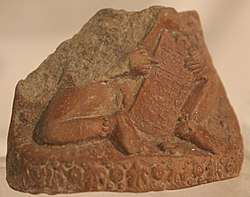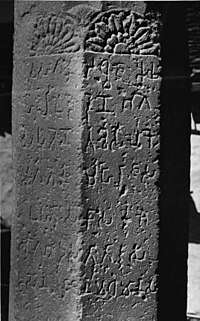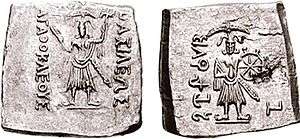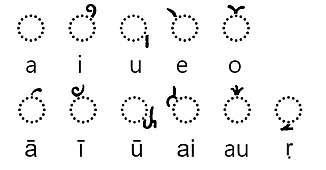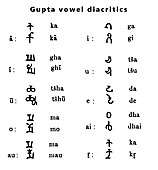Brahmi script
Brahmi (/ˈbrɑːmi/; IAST: Brāhmī) is the modern name[2] for a writing system of ancient India.[3] The Brahmi writing system, or script, appeared as a fully developed universal one in South Asia in the third century BCE,[3] and is a forerunner of all writing systems that have found use in South Asia with the exception of the Indus script of the third millennium BCE, the Kharosthi script, which originated in what today is northwestern Pakistan in the fourth or possibly fifth century BCE,[4] the Perso-Arabic Scripts of the medieval period, and the Latin scripts of the modern period.[3] Its descendants, the Brahmic scripts, continue to be in use today not only in South Asia, but also Southeast Asia.[5][6][7] Brahmi is an abugida which uses a system of diacritical marks to associate vowels with consonant symbols.
| Brāhmī | |
|---|---|
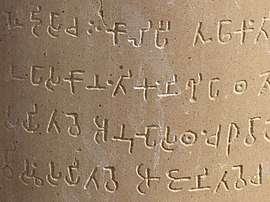 Brahmi script on Ashoka Pillar (circa 250 BCE) | |
| Type | |
| Languages | Sanskrit, Prakrit, Saka, Tamil, Tocharian |
Time period | 4th or 3rd century BCE[1][a] to 5th century CE |
Parent systems | Proto-Sinaitic script[b]
|
Child systems | Gupta and numerous descendant writing systems |
Sister systems | Kharoṣṭhī |
| Direction | Left-to-right |
| ISO 15924 | Brah, 300 |
Unicode alias | Brahmi |
Unicode range | U+11000–U+1107F |
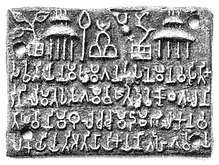
Several divergent accounts of the origin of the name "Brahmi" appear in history and legend. Several Sutras of Jainism such as the Vyakhya Pragyapti Sutra, the Samvayanga Sutra and the Pragyapna Sutra of the Jain Agamas include a list of 18 writing scripts known to teachers before the Mahavira was born, with the Brahmi script (bambhī in the original Prakrit) leading all these lists. The Brahmi script is missing from the 18 script list in the surviving versions of two later Jaina Sutras, namely the Vishesha Avashyaka and the Kalpa Sutra. Jain legend recounts that 18 writing scripts were taught by their first Tirthankara Rishabhanatha to his daughter Brahmi, she emphasized Brahmi as the main script as she taught others, and therefore the name Brahmi for the script comes after her name.[8]
The earliest (indisputably dated) and best-known Brahmi inscriptions are the rock-cut edicts of Ashoka in north-central India, dating to 250–232 BCE. Brahmi only went through relatively minor evolutionary changes from the Mauryan period (3rd century BCE) down to the early Gupta period (4th century CE), and it is thought that as late as the 4th century CE, a literate person could still read and understand Mauryan inscriptions.[9]
Later the script underwent important changes, and the capability to read the original Brahmi script was lost. The first successful attempts at deciphering Brahmi were made in 1836 by Norwegian scholar Christian Lassen, who used the bilingual Greek-Brahmi coins of Indo-Greek kings Agathocles and Pantaleon to correctly identify several Brahmi letters.[10] The script was then fully deciphered in 1837 by James Prinsep, an archaeologist, philologist, and official of the East India Company, with the help of Alexander Cunningham.[11][10][12] The origin of the script is still much debated, with most scholars stating that Brahmi was derived from or at least influenced by one or more contemporary Semitic scripts, while others favor the idea of an indigenous origin or connection to the much older and as-yet undeciphered Indus script of the Indus Valley Civilization.[13][14]
Brahmi was at one time referred to in English as the "pin-man" script,[15] that is "stick figure" script. It was known by a variety of other names[16] until the 1880s when Albert Étienne Jean Baptiste Terrien de Lacouperie, based on an observation by Gabriel Devéria, associated it with the Brahmi script, the first in a list of scripts mentioned in the Lalitavistara Sūtra. Thence the name was adopted in the influential work of Georg Bühler, albeit in the variant form "Brahma".[17] The Gupta script of the fifth century is sometimes called "Late Brahmi". The Brahmi script diversified into numerous local variants classified together as the Brahmic scripts. Dozens of modern scripts used across South Asia have descended from Brahmi, making it one of the world's most influential writing traditions.[18] One survey found 198 scripts that ultimately derive from it.[19]
Among the inscriptions of Ashoka ca. 3rd-century BCE written in the Brahmi script a few numerals were found, which have come to be called the Brahmi numerals.[20] The numerals are additive and multiplicative and, therefore, not place value;[20] it is not known if their underlying system of numeration has a connection to the Brahmi script.[20] But in the second half of the first millennium CE, some inscriptions in India and Southeast Asia written in scripts derived from the Brahmi did include numerals that are decimal place value, and constitute the earliest existing material examples of the Hindu-Arabic numeral system, now in use throughout the world.[21] The underlying system of numeration, however, was older, as the earliest attested orally transmitted example dates to the middle of the 3rd century CE in a Sanskrit prose adaptation of a lost Greek work on astrology.[22][23][24]
Texts
The Brahmi script is mentioned in the ancient Indian texts of Hinduism, Jainism and Buddhism, as well as their Chinese translations.[26][27] For example, the Lipisala samdarshana parivarta lists 64 lipi (scripts), with the Brahmi script starting the list. The Lalitavistara Sūtra states that young Siddhartha, the future Gautama Buddha (~500 BCE), mastered philology, Brahmi and other scripts from the Brahmin Lipikāra and Deva Vidyāiṃha at a school.[28][26]
A list of eighteen ancient scripts is found in the texts of Jainism, such as the Pannavana Sutra (2nd century BCE) and the Samavayanga Sutra (3rd century BCE).[29][30] These Jaina script lists include Brahmi at number 1 and Kharoṣṭhi at number 4 but also Javanaliya (probably Greek) and others not found in the Buddhist lists.[30]
Origins
While the contemporary Kharoṣṭhī script is widely accepted to be a derivation of the Aramaic alphabet, the genesis of the Brahmi script is less straightforward. Salomon reviewed existing theories in 1998,[5] while Falk provided an overview in 1993.[31]
Early theories proposed a pictographic-acrophonic origin for the Brahmi script, on the model of the Egyptian hieroglyphic script. These ideas however have lost credence, as they are "purely imaginative and speculative".[32] Similar ideas have tried to connect the Brahmi script with the Indus script, but they remain unproven, and particularly suffer from the fact that the Indus script is as yet undeciphered.[32]
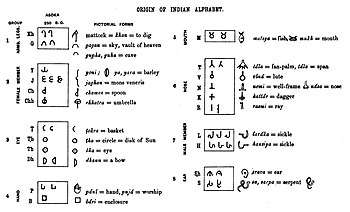
An origin in Semitic scripts (usually the Aramaic or Phoenician alphabet) is accepted by all script scholars since the publications by Albrecht Weber (1856) and Georg Bühler's On the origin of the Indian Brahma alphabet (1895).[33][6] Bühler's ideas have been particularly influential, though even by the 1895 date of his opus on the subject, he could identify no fewer than five competing theories of the origin, one positing an indigenous origin and the others deriving it from various Semitic models.[34]
The most disputed point about the origin of the Brahmi script has long been whether it was a purely indigenous development or was borrowed or derived from scripts that originated outside India. Goyal (1979)[35] noted that most proponents of the indigenous view are Indian scholars, whereas the theory of Semitic origin is held by "nearly all" Western scholars, and Salomon agrees with Goyal that there has been "nationalist bias" and "imperialist bias" on the two respective sides of the debate.[36] In spite of this, the view of indigenous development had been prevalent among British scholars writing prior to Bühler: A passage by Alexander Cunningham, one of the earliest indigenous origin proponents, suggests that, in his time, the indigenous origin was a preference of British scholars in opposition to the "unknown Western" origin preferred by continental scholars.[34] Cunningham in the seminal Corpus Inscriptionum Indicarum of 1877 speculated that Brahmi characters were derived from, among other things, a pictographic principle based on the human body,[37] but Bühler noted that by 1891, Cunningham considered the origins of the script uncertain.
Most scholars believe that Brahmi was likely derived from or influenced by a Semitic script model, with Aramaic being a leading candidate.[40] However, the issue is not settled due to the lack of direct evidence and unexplained differences between Aramaic, Kharoṣṭhī, and Brahmi.[41] Though Brahmi and the Kharoṣṭhī script share some general features, the differences between the Kharosthi and Brahmi scripts are "much greater than their similarities," and "the overall differences between the two render a direct linear development connection unlikely", states Richard Salomon.[42]
Virtually all authors accept that regardless of the origins, the differences between the Indian script and those proposed to have influenced it are significant. The degree of Indian development of the Brahmi script in both the graphic form and the structure has been extensive. It is also widely accepted that theories about the grammar of the Vedic language probably had a strong influence on this development. Some authors – both Western and Indian – suggest that Brahmi was borrowed or inspired by a Semitic script, invented in a short few years during the reign of Ashoka and then used widely for Ashokan inscriptions.[41] In contrast, some authors reject the idea of foreign influence.[43][44]
Bruce Trigger states that Brahmi likely emerged from the Aramaic script but with extensive local development but there is no evidence of a direct common source.[45] According to Trigger, Brahmi was in use before the Ashoka pillars, at least by 4th or 5th century BCE in Sri Lanka and India, while Kharoṣṭhī was used only in northwest South Asia (eastern parts of modern Afghanistan and neighboring regions of Pakistan) for a while before it died out in ancient times.[45] According to Salomon, the evidence of Kharosthi script's use is found primarily in Buddhist records and those of Indo-Greek, Indo-Scythian, Indo-Parthian and Kushana dynasty era. The Kharosthi likely fell out of general use in or about the 3rd-century CE.[42]
Justeson and Stephens proposed that this inherent vowel system in Brahmi and Kharoṣṭhī developed by transmission of a Semitic abjad through the recitation of its letter values. The idea is that learners of the source alphabet recite the sounds by combining the consonant with an unmarked vowel, e.g. /kə/,/kʰə/,/gə/, and in the process of borrowing into another language, these syllables are taken to be the sound values of the symbols. They also accepted the idea that Brahmi was based on a North Semitic model.[46]
Semitic model hypothesis
| IAST | -aspirate | +aspirate | origin of aspirate according to Bühler |
|---|---|---|---|
| k/kh | Semitic emphatic (qoph) | ||
| g/gh | Semitic emphatic (heth) (hook addition in Bhattiprolu script) | ||
| c/ch | curve addition | ||
| j/jh | hook addition with some alteration | ||
| p/ph | curve addition | ||
| b/bh | hook addition with some alteration | ||
| t/th | Semitic emphatic (teth) | ||
| d/dh | unaspirated glyph back formed | ||
| ṭ/ṭh | unaspirated glyph back formed as if aspirated glyph with curve | ||
| ḍ/ḍh | curve addition |
Many scholars link the origin of Brahmi to Semitic script models, particularly Aramaic.[33] The explanation of how this might have happened, the particular Semitic script and the chronology have been the subject of much debate. Bühler followed Max Weber in connecting it particularly to Phoenician and proposed an early 8th century BCE date[47] for the borrowing. A link to the South Semitic script, a less prominent branch of the Semitic script family, has occasionally been proposed but has not gained much acceptance.[48] Finally, the Aramaic script being the prototype for Brahmi has been the more preferred hypothesis because of its geographic proximity to the Indian subcontinent, and its influence likely arising because Aramaic was the bureaucratic language of the Achaemenid empire. However, this hypothesis does not explain the mystery of why two very different scripts, Kharoṣṭhī and Brahmi, developed from the same Aramaic. A possible explanation might be that Ashoka created an imperial script for his edicts, but there is no evidence to support this conjecture.[49]
Bühler's theory
According to the Semitic hypothesis as laid out by Bühler in 1898, the oldest Brahmi inscriptions were derived from a Phoenician prototype.[50][note 1] Salomon states Bühler's arguments are "weak historical, geographical, and chronological justifications for a Phoenician prototype". Discoveries made since Bühler's proposal, such as of six Mauryan inscriptions in Aramaic, suggest Bühler's proposal about Phoenician as weak. It is more likely that Aramaic, which was virtually certain the prototype for Kharoṣṭhī, also may have been the basis for Brahmi. However, it is unclear why the ancient Indians would have developed two very different scripts.[49]
| Phoenician | Aramaic | Value | Brahmi | Value |
|---|---|---|---|---|
| * | a | |||
| b [b] | ba | |||
| g [ɡ] | ga | |||
| d [d] | dha | |||
| h [h], M.L. | ha | |||
| w [w], M.L. | va | |||
| z [z] | ja | |||
| ḥ [ħ] | gha | |||
| ṭ [tˤ] | tha | |||
| y [j], M.L. | ya | |||
| k [k] | ka | |||
| l [l] | la | |||
| m [m] | ma | |||
| n [n] | na | |||
| s [s] | ṣa | |||
| ʿ [ʕ], M.L. | e | |||
| p [p] | pa | |||
| ṣ [sˤ] | ca | |||
| q [q] | kha | |||
| r [r] | ra | |||
| š [ʃ] | śa | |||
| t [t] | ta | |||
According to Bühler, Brahmi added symbols for certain sounds not found in Semitic languages, and either deleted or repurposed symbols for Aramaic sounds not found in Prakrit. For example, Aramaic lacks the phonetic retroflex feature that appears among Prakrit dental stops, such as ḍ, and in Brahmi the symbols of the retroflex and non-retroflex consonants are graphically very similar, as if both had been derived from a single prototype. (See Tibetan alphabet for a similar later development.) Aramaic did not have Brahmi's aspirated consonants (kh, th, etc.), whereas Brahmi did not have Aramaic's emphatic consonants (q, ṭ, ṣ), and it appears that these unneeded emphatic letters filled in for some of Brahmi's aspirates: Aramaic q for Brahmi kh, Aramaic ṭ (Θ) for Brahmi th (ʘ), etc. And just where Aramaic did not have a corresponding emphatic stop, p, Brahmi seems to have doubled up for the corresponding aspirate: Brahmi p and ph are graphically very similar, as if taken from the same source in Aramaic p. Bühler saw a systematic derivational principle for the other aspirates ch, jh, ph, bh, and dh, which involved adding a curve or upward hook to the right side of the character (which has been speculated to derive from h, ![]()
The attached table lists the correspondences between Brahmi and North Semitic scripts.[55][52]
Bühler states that both Phoenician and Brahmi had three voiceless sibilants, but because the alphabetical ordering was lost, the correspondences among them are not clear. Bühler was able to suggest Brahmi derivatives corresponding to all of the 22 North Semitic characters, though clearly, as Bühler himself recognized, some are more confident than others. He tended to place much weight on phonetic congruence as a guideline, for example connecting c ![]()
![]()
![]()
One of the key problems with a Phoenician derivation is the lack of evidence for historical contact with Phoenicians in the relevant period.[49] Bühler explained this by proposing that the initial borrowing of Brahmi characters dates back considerably earlier than the earliest known evidence, as far back as 800 BCE, contemporary with the Phoenician glyph forms that he mainly compared. Bühler cited a near-modern practice of writing Brahmic scripts informally without vowel diacritics as a possible continuation of this earlier abjad-like stage in development.[47]
The weakest forms of the Semitic hypothesis are similar to Gnanadesikan's trans-cultural diffusion view of the development of Brahmi and Kharoṣṭhī, in which the idea of alphabetic sound representation was learned from the Aramaic-speaking Persians, but much of the writing system was a novel development tailored to the phonology of Prakrit.[56]
Another evidence cited in favor of Persian influence has been the Hultzsch proposal in 1925 that the Prakrit/Sanskrit word for writing itself, lipi is similar to the Old Persian word dipi, suggesting a probable borrowing.[57][58] A few of the Ashoka edicts from the region nearest the Persian empire use dipi as the Prakrit word for writing, which appears as lipi elsewhere, and this geographic distribution has long been taken, at least back to Bühler's time, as an indication that the standard lipi form is a later alteration that appeared as it diffused away from the Persian sphere of influence. Persian dipi itself is thought to be an Elamite loanword.[59]
Greek-Semitic model hypothesis
Falk's 1993 book Schrift im Alten Indien is considered a definitive study on writing in ancient India.[60][61] Falk's section on the origins of the Brahmi script[31] features an extensive review of the literature up to that time. Falk also puts forth his own ideas. As have a number of other authors, Falk sees the basic writing system of Brahmi as being derived from the Kharoṣṭhī script, itself a derivative of Aramaic. At the time of his writing, the Ashoka edicts were the oldest confidently dateable examples of Brahmi, and he perceives in them "a clear development in language from a faulty linguistic style to a well honed one"[62] over time, which he takes to indicate that the script had been recently developed.[31][63] Falk deviates from the mainstream of opinion in seeing Greek as also being a significant source for Brahmi. On this point particularly, Salomon disagrees with Falk, and after presenting evidence of very different methodology between Greek and Brahmi notation of vowel quantity, he states "it is doubtful whether Brahmi derived even the basic concept from a Greek prototype".[64] Further, adds Salomon, in a "limited sense Brahmi can be said to be derived from Kharosthi, but in terms of the actual forms of the characters, the differences between the two Indian scripts are much greater than the similarities".[65]
Falk also dated the origin of Kharoṣṭhī to no earlier than 325 BCE, based on a proposed connection to the Greek conquest.[66] Salomon questions Falk's arguments as to the date of Kharoṣṭhī and writes that it is "speculative at best and hardly constitutes firm grounds for a late date for Kharoṣṭhī. The stronger argument for this position is that we have no specimen of the script before the time of Ashoka, nor any direct evidence of intermediate stages in its development; but of course this does not mean that such earlier forms did not exist, only that, if they did exist, they have not survived, presumably because they were not employed for monumental purposes before Ashoka".[63]
Unlike Bühler, Falk does not provide details of which and how the presumptive prototypes may have been mapped to the individual characters of Brahmi. Further, states Salomon, Falk accepts there are anomalies in phonetic value and diacritics in Brahmi script that are not found in the presumed Kharoṣṭhī script source. Falk attempts to explain these anomalies by reviving the Greek influence hypothesis, a hypothesis that had previously fallen out of favor.[63][67]
Hartmut Scharfe, in his 2002 review of Kharoṣṭī and Brāhmī scripts, concurs with Salomon's questioning of Falk's proposal, and states, "the pattern of the phonemic analysis of the Sanskrit language achieved by the Vedic scholars is much closer to the Brahmi script than the Greek alphabet".[14]
As of 2018, Harry Falk refined his view by affirming that Brahmi was developed from scratch in a rational way at the time of Ashoka, by consciously combining the advantages of the pre-existing Greek script and northern Kharosthi script.[68] Greek-style letter types were selected for their "broad, upright and symmetrical form", and writing from left to right was also adopted for its convenience.[68] On the other hand, the Kharosthi treatment of vowels was retained, with its inherent vowel "a", derived from Aramaic, and stroke additions to represent other vowel signs.[68] In addition, a new system of combining consonants vertically to represent complex sounds was also developed.[68]
Indigenous origin theory
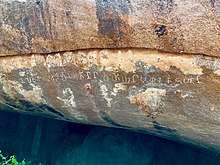
The idea of an indigenous origin such as a connection to the Indus script is supported by some Western and Indian scholars and writers. The theory that there are similarities to the Indus script was suggested by early European scholars such as the archaeologist John Marshall[71] and the Assyriologist Stephen Langdon,[72] and it continues to be suggested by scholars and writers such as (among others) the computer scientist Subhash Kak, the German Indologist Georg Feuerstein, the American teacher David Frawley, the British archaeologist Raymond Allchin, and the social anthropologist Jack Goody.[73][74]
Raymond Allchin states that there is a powerful argument against the idea that the Brahmi script has Semitic borrowing because the whole structure and conception is quite different. He suggests that the origin may have been purely indigenous with the Indus script as its predecessor.[76] However, Allchin and Erdosy later in 1995 expressed the opinion that there was as yet insufficient evidence to resolve the question.[77] G.R. Hunter in his book The Script of Harappa and Mohenjodaro and Its Connection with Other Scripts (1934) proposed a derivation of the Brahmi alphabets from the Indus Script, the match being considerably higher than that of Aramaic in his estimation.[78]
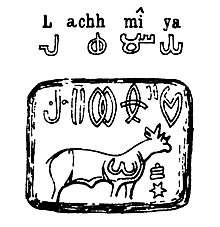
Subhash Kak disagrees with the proposed Semitic origins of the script,[79] instead states that the interaction between the Indic and the Semitic worlds before the rise of the Semitic scripts might imply a reverse process.[80] However, the chronology thus presented and the notion of an unbroken tradition of literacy is opposed by a majority of academics who support an indigenous origin. Evidence for a continuity between Indus and Brahmi has also been seen in graphic similarities between Brahmi and the late Indus script, where the ten most common ligatures correspond with the form of one of the ten most common glyphs in Brahmi.[81] There is also corresponding evidence of continuity in the use of numerals.[82] Further support for this continuity comes from statistical analysis of the relationship carried out by Das.[83] Salomon considered simple graphic similarities between characters to be insufficient evidence for a connection without knowing the phonetic values of the Indus script, though he found apparent similarities in patterns of compounding and diacritical modification to be "intriguing." However, he felt that it was premature to explain and evaluate them due to the large chronological gap between the scripts and the thus far indecipherable nature of the Indus script.[84]
The main obstacle to this idea is the lack of evidence for writing during the millennium and a half between the collapse of the Indus Valley Civilisation around 1500 BCE and the first widely accepted appearance of Brahmi in the 3rd or 4th centuries BCE. Iravathan Mahadevan makes the point that even if one takes the latest dates of 1500 BCE for the Indus script and earliest claimed dates of Brahmi around 500 BCE, a thousand years still separates the two.[85] Furthermore, there is no accepted decipherment of the Indus script, which makes theories based on claimed decipherments tenuous. A promising possible link between the Indus script and later writing traditions may be in the megalithic graffiti symbols of the South Indian megalithic culture, which may have some overlap with the Indus symbol inventory and persisted in use up at least through the appearance of the Brahmi and Tamil Brahmi scripts up into the third century CE. These graffiti usually appear singly, though on occasion may be found in groups of two or three, and are thought to have been family, clan, or religious symbols.[86] In 1935, C.L. Fábri proposed that symbols found on Mauryan punch-marked coins were remnants of the Indus script that had survived the collapse of the Indus civilization.[87] Iravatham Mahadevan, decipherer of Tamil-Brahmi and a noted expert on the Indus script, has supported the idea that both those semiotic traditions may have some continuity with the Indus script, but regarding the idea of continuity with Brahmi, he has categorically stated that he does not believe that theory "at all".[85]
Another form of the indigenous origin theory is that Brahmi was invented ex nihilo, entirely independently from either Semitic models or the Indus script, though Salomon found these theories to be wholly speculative in nature.[88]
Foreign origination
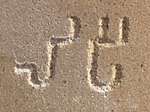
𑀮La+𑀺i; pī=𑀧Pa+𑀻ii). The word would be of Old Persian origin ("Dipi").Pāṇini (6th to 4th century BCE) mentions lipi, the Indian word for writing scripts in his definitive work on Sanskrit grammar, the Ashtadhyayi. According to Scharfe, the words lipi and libi are borrowed from the Old Persian dipi, in turn derived from Sumerian dup.[58][89] To describe his own Edicts, Ashoka used the word Lipī, now generally simply translated as "writing" or "inscription". It is thought the word "lipi", which is also orthographed "dipi" in the two Kharosthi-version of the rock edicts,[note 3] comes from an Old Persian prototype dipî also meaning "inscription", which is used for example by Darius I in his Behistun inscription,[note 4] suggesting borrowing and diffusion.[90][91][92]
Scharfe adds that the best evidence, is that no script was used or ever known in India, aside from the Persian-dominated Northwest where Aramaic was used, before around 300 BCE because Indian tradition "at every occasion stresses the orality of the cultural and literary heritage"[58] , yet Scharfe in the same book admits that "a script has been discovered in the excavations of the Indus Valley Civilization that flourished in the Indus valley and adjacent areas in the third millennium B.C. The number of different signs suggest a syllabic script, but all attempts at decipherment have been unsuccessful so far. Attempts by some Indian scholars to connect this undeciphered script with the Indian scripts in vogue from the third century B.C. onward are total failures." [93]
Megasthenes observations
Megasthenes, a Greek ambassador to the Mauryan court in Northeastern India only a quarter century before Ashoka, noted "… and this among a people who have no written laws, who are ignorant even of writing, and regulate everything by memory."[94] This has been variously and contentiously interpreted by many authors. Ludo Rocher almost entirely dismisses Megasthenes as unreliable, questioning the wording used by Megasthenes' informant and Megasthenes' interpretation of them.[95] Timmer considers it to reflect a misunderstanding that the Mauryans were illiterate "based upon the fact that Megasthenes rightly observed that the laws were unwritten and that oral tradition played such an important part in India."[96]
Some proponents of the indigenous origin theories question the reliability and interpretation of comments made by Megasthenes (as quoted by Strabo in the Geographica XV.i.53). For one, the observation may only apply in the context of the kingdom of "Sandrakottos" (Chandragupta). Elsewhere in Strabo (Strab. XV.i.39), Megasthenes is said to have noted that it was a regular custom in India for the "philosopher" caste (presumably Brahmins) to submit "anything useful which they have committed to writing" to kings,[97] but this detail does not appear in parallel extracts of Megasthenes found in Arrian and Diodorus Siculus.[98][99] The implication of writing per se is also not totally clear in the original Greek as the term "συντάξῃ" (cognate with the English word "syntax") can be read as a generic "composition" or "arrangement", rather than a written composition in particular. Nearchus, a contemporary of Megasthenes, noted, a few decades prior, the use of cotton fabric for writing in Northern India. Indologists have variously speculated that this might have been Kharoṣṭhī or the Aramaic alphabet. Salomon regards the evidence from Greek sources to be inconclusive.[100] Strabo himself notes this inconsistency regarding reports on the use of writing in India (XV.i.67).
Debate on time depth
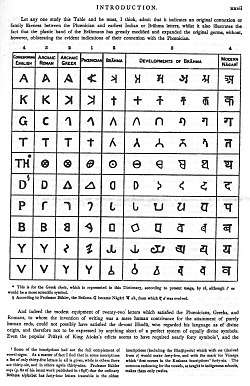
Kenneth Norman (2005) suggests that Brahmi was devised over a longer period of time predating Ashoka's rule:[101]
- "Support for this idea of pre-Ashokan development has been given very recently by the discovery of sherds at Anuradhapura in Sri Lanka, inscribed with small numbers of characters which seem to be Brāhmī. These sherds have been dated, by both Carbon 14 and Thermo-luminescence dating, to pre-Ashokan times, perhaps as much as much as two centuries before Ashoka."[102]
Jack Goody (1987) had similarly suggested that ancient India likely had a "very old culture of writing" along with its oral tradition of composing and transmitting knowledge, because the Vedic literature is too vast, consistent and complex to have been entirely created, memorized, accurately preserved and spread without a written system.[103][104]
Opinions on this point, the possibility that there may not have been any writing scripts including Brahmi during the Vedic age, given the quantity and quality of the Vedic literature, are divided. While Falk (1993) disagrees with Goody,[105] while Walter Ong and John Hartley (2012) concur,[106] not so much based on the difficulty of orally preserving the Vedic hymns, but on the basis that it is highly unlikely that Panini's grammar was composed. Johannes Bronkhorst (2002) takes the intermediate position that the oral transmission of the Vedic hymns may well have been achieved orally, but that the development of Panini's grammar presupposes writing (consistent with a development of Indian writing in c. the 4th century BCE).[60]
Origin of the name
Several divergent accounts of the origin of the name "Brahmi" appear in history and legend. Several Sutras of Jainism such as the Vyakhya Pragyapti Sutra, the Samvayanga Sutra and the Pragyapna Sutra of the Jain Agamas include a list of 18 writing scripts known to teachers before the Mahavira was born, with the Brahmi script (bambhī in the original Prakrit) leading all these lists. The Brahmi script is missing from the 18 script list in the surviving versions of two later Jaina Sutras, namely the Vishesha Avashyaka and the Kalpa Sutra. Jain legend recounts that 18 writing scripts were taught by their first Tirthankara Rishabhanatha to his daughter Brahmi, she emphasized Brahmi as the main script as she taught others, and therefore the name Brahmi for the script comes after her name.[8]
A Chinese Buddhist account of the 6th century CE attributes its creation to the god Brahma, though Monier Monier-Williams, Sylvain Lévi and others thought it was more likely to have been given the name because it was moulded by the Brahmins.[107][108]
The term Brahmi appears in ancient Indian texts in different contexts. According to the rules of the Sanskrit language, it is a feminine word which literally means "of Brahma" or "the female energy of the Brahman".[109] In other texts such as the Mahabharata, it appears in the sense of a goddess, particularly for Saraswati as the goddess of speech and elsewhere as "personified Shakti (energy) of Brahma".[110]
History
The earliest known full inscriptions of Brahmi are in Prakrit, dated to be from the 3rd to 1st centuries BCE, particularly the Edicts of Ashoka, c. 250 BCE.[111] Prakrit records predominate the epigraphic records discovered in the Indian subcontinent through about the 1st century CE.[111] The earliest known Brahmi inscriptions in Sanskrit are from the 1st century BCE, such as the few discovered in Ayodhya, Ghosundi and Hathibada (both near Chittorgarh).[112][note 5] Ancient inscriptions have also been discovered in many North and Central Indian sites, occasionally in South India as well, that are in hybrid Sanskrit-Prakrit language called "Epigraphical Hybrid Sanskrit".[note 6] These are dated by modern techniques to between the 1st and 4th centuries CE.[115][116] Surviving ancient records of the Brahmi script are found as engravings on pillars, temple walls, metal plates, terracotta, coins, crystals and manuscripts.[117][116]
One of the most important recent developments regarding the origin of Brahmi has been the discovery of Brahmi characters inscribed on fragments of pottery from the trading town of Anuradhapura in Sri Lanka, which have been dated between the sixth to early fourth century BCE.[118] Coningham et al. in 1996,[119] stated that the script on the Anuradhapura inscriptions is Brahmi, but stated that the language was a Prakrit rather than a Dravidian language. The historical sequence of the specimens was interpreted to indicate an evolution in the level of stylistic refinement over several centuries, and they concluded that the Brahmi script may have arisen out of "mercantile involvement" and that the growth of trade networks in Sri Lanka was correlated with its first appearance in the area.[119] Salomon in his 1998 review states that the Anuradhapura inscriptions support the theory that Brahmi existed in South Asia before the Mauryan times, with studies favoring the 4th century BCE, but some doubts remain whether the inscriptions might be intrusive into the potsherds from a later date.[118] Indologist Harry Falk has argued that the Edicts of Ashoka represent an older stage of Brahmi, whereas certain paleographic features of even the earliest Anuradhapura inscriptions are likely to be later, and so these potsherds may date from after 250 BCE.[120]
More recently in 2013, Rajan and Yatheeskumar published excavations at Porunthal and Kodumanal in Tamil Nadu, where numerous both Tamil-Brahmi and "Prakrit-Brahmi" inscriptions and fragments have been found.[121] Their stratigraphic analysis combined with radiocarbon dates of paddy grains and charcoal samples indicated that inscription contexts date to as far back as the 6th and perhaps 7th centuries BCE.[122] As these were published very recently, they have as yet not been commented on extensively in the literature. Indologist Harry Falk has criticized Rajan's claims as "particularly ill-informed"; Falk argues that some of the earliest supposed inscriptions are not Brahmi letters at all, but merely misinterpreted non-linguistic Megalithic graffiti symbols, which were used in South India for several centuries during the pre-literate era.[123]
Decipherment
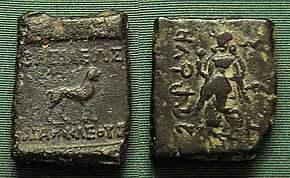
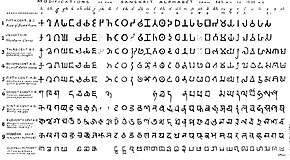
Besides a few inscriptions in Greek and Aramaic (which were only discovered in the 20th century), the Edicts of Ashoka were written in the Brahmi script and sometimes in the Kharoshthi script in the northwest, which had both become extinct around the 4th century CE, and were yet undeciphered at the time the Edicts were discovered and investigated in the 19th century.[125][10]
Inscriptions of the 6th century CE in late Brahmi were already deciphered in 1785 by Charles Wilkins, who published an essentially correct translation of the Gopika Cave Inscription written by the Maukhari king Anantavarman.[126] Wilkins seems to have relied essentially on the similarities with later Brahmic scripts, such as the script of the Pala period and early forms of Devanagari.[126]
Early Brahmi however remained unreadable.[126] Progress resumed in 1834 with the publication of proper facsimiles of the inscriptions on the Allahabad pillar of Ashoka, notably containing Edicts of Ashoka as well as inscriptions by the Gupta Empire ruler Samudragupta.[127] James Prinsep, an archaeologist, philologist, and official of the East India Company, started to analyse the inscriptions and made deductions on the general characteristics of the early Brahmi script essentially relying on statistical methods.[127] The same year, in 1834, some attempts by Rev. J. Stevenson were made to identify intermediate early Brahmi characters from the Karla Caves (circa 1st century CE) based on their similarities with the Gupta script of the Samudragupta inscription of the Allahabad pillar (4th century CE) which had just been published, but this led to a mix of good (about 1/3) and bad guesses, which did not permit proper decipherment of the Brahmi.[128][127]
The next major step towards deciphering the ancient Brahmi script of the 3rd-2nd centuries BCE was made in 1836 by Norwegian scholar Christian Lassen, who used a bilingual Greek-Brahmi coin of Indo-Greek king Agathocles and similarities with the Pali script to correctly and securely identify several Brahmi letters.[10][127][129] The matching legends on the bilingual coins of Agathocles were:
Greek legend: ΒΑΣΙΛΕΩΣ / ΑΓΑΘΟΚΛΕΟΥΣ (Basileōs Agathokleous, "King Agathocles")
Brahmi legend:𑀭𑀚𑀦𑁂 / 𑀅𑀕𑀣𑀼𑀼𑀓𑁆𑀮𑁂𑀬𑁂𑀲 (Rajane Agathukleyesa, "King Agathocles").[130]
James Prinsep was then able to complete the decipherment of the Brahmi script.[127][11][10][12] After acknowledging Lassen's first decipherment,[131] Prinsep used a bilingual coin of Indo-Greek king Pantaleon to decipher a few more letters.[129] James Prinsep then analysed a large number of donatory inscriptions on the reliefs in Sanchi, and noted that most of them ended with the same two Brahmi characters: "𑀤𑀦𑀁". Prinsep guessed correctly that they stood for "danam", the Sanskrit word for "gift" or "donation", which permitted to further increase the number of known letters.[127][132] With the help of Ratna Pâla, a Singhalese Pali scholar and linguist, Prinsep then completed the full decipherment of the Brahmi script.[133][134][135][136] In a series of results that he published in March 1838 Prinsep was able to translate the inscriptions on a large number of rock edicts found around India, and provide, according to Richard Salomon, a "virtually perfect" rendering of the full Brahmi alphabet.[137][138]
Southern Brahmi
Ashokan inscriptions are found all over India and a few regional variants have been observed. The Bhattiprolu alphabet, with earliest inscriptions dating from a few decades of Ashoka's reign, is believed to have evolved from a southern variant of the Brahmi alphabet. The language used in these inscriptions, nearly all of which have been found upon Buddhist relics, is exclusively Prakrit, though Kannada and Telugu proper names have been identified in some inscriptions. Twenty-three letters have been identified. The letters ga and sa are similar to Mauryan Brahmi, while bha and da resemble those of modern Kannada and Telugu script.
Tamil-Brahmi is a variant of the Brahmi alphabet that was in use in South India by about 3rd century BCE, particularly in Tamil Nadu and Kerala. Inscriptions attest their use in parts of Sri Lanka in the same period. The language used in around 70 Southern Brahmi inscriptions discovered in the 20th century have been identified as a Prakrit language.[69][70]
In English, the most widely available set of reproductions of Brahmi texts found in Sri Lanka is Epigraphia Zeylanica; in volume 1 (1976), many of the inscriptions are dated from the 3rd to 2nd century BCE.[139]
Unlike the edicts of Ashoka, however, the majority of the inscriptions from this early period in Sri Lanka are found above caves. The language of Sri Lanka Brahmi inscriptions has been mostly been Prakrit though some Tamil-Brahmi inscriptions have also been found, such as the Annaicoddai seal.[140] The earliest widely accepted examples of writing in Brahmi are found in Anuradhapura, Sri Lanka.[119]
Red Sea and Southeast Asia
The Khuan Luk Pat inscription discovered in Thailand is in Tamil Brahmi script. Its date is uncertain and has been proposed to be from the early centuries of the common era.[141][142] According to Frederick Asher, Tamil Brahmi inscriptions on potsherds have been found in Quseir al-Qadim and in Berenike, Egypt which suggest that merchant and trade activity was flourishing in ancient times between India and the Red Sea region.[142] Additional Tamil Brahmi inscription has been found in Khor Rori region of Oman on an archaeological site storage jar.[142]
Characteristics
Brahmi is usually written from left to right, as in the case of its descendants. However, an early coin found in Eran is inscribed with Brahmi running from right to left, as in Aramaic. Several other instances of variation in the writing direction are known, though directional instability is fairly common in ancient writing systems.[143]
Consonants
Brahmi is an abugida, meaning that each letter represents a consonant, while vowels are written with obligatory diacritics called mātrās in Sanskrit, except when the vowels commence a word. When no vowel is written, the vowel /a/ is understood. This "default short a" is a characteristic shared with Kharosthī, though the treatment of vowels differs in other respects.

Conjunct consonants
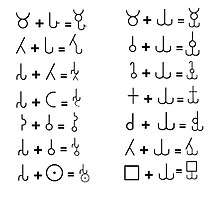
Special conjunct consonants are used to write consonant clusters such as /pr/ or /rv/. In modern Devanagari the components of a conjunct are written left to right when possible (when the first consonant has a vertical stem that can be removed at the right), whereas in Brahmi characters are joined vertically downwards.
_conjunct_consonant.jpg)
.jpg) Sva (Sa+Va)
Sva (Sa+Va).jpg) Sya (Sa+Ya)
Sya (Sa+Ya).jpg) Hmī (Ha+Ma+i+i), as in the word "Brāhmī" (𑀩𑁆𑀭𑀸𑀳𑁆𑀫𑀻).
Hmī (Ha+Ma+i+i), as in the word "Brāhmī" (𑀩𑁆𑀭𑀸𑀳𑁆𑀫𑀻).
Vowels

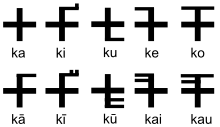
Vowels following a consonant are inherent or written by diacritics, but initial vowels have dedicated letters. There are three "primary" vowels in Ashokan Brahmi, which each occur in length-contrasted forms: /a/, /i/, /u/; long vowels are derived from the letters for short vowels. There are also four "secondary" vowels that do not have the long-short contrast, /e/, /ai/, /o/, /au/.[144] Note though that the grapheme for /ai/ is derivative from /e/ in a way which parallels the short-long contrast of the primary vowels. However, there are only nine distinct vowel diacritics, as short /a/ is understood if no vowel is written. The initial vowel symbol for /au/ is also apparently lacking in the earliest attested phases, even though it has a diacritic. Ancient sources suggest that there were either 11 or 12 vowels enumerated at the beginning of the character list around the Ashokan era, probably adding either aṃ or aḥ.[145] Later versions of Brahmi add vowels for four syllabic liquids, short and long /ṛ/ and /ḷ/. Chinese sources indicate that these were later inventions by either Nagarjuna or Śarvavarman, a minister of King Hāla.[146]
It has been noted that the basic system of vowel marking common to Brahmi and Kharosthī, in which every consonant is understood to be followed by a vowel, was well suited to Prakrit,[147] but as Brahmi was adapted to other languages, a special notation called the virāma was introduced to indicate the omission of the final vowel. Kharoṣṭhī also differs in that the initial vowel representation has a single generic vowel symbol that is differentiated by diacritics, and long vowels are not distinguished.
The collation order of Brahmi is believed to have been the same as most of its descendant scripts, one based on Shiksha, the traditional Vedic theory of Sanskrit phonology. This begins the list of characters with the initial vowels (starting with a), then lists a subset of the consonants in 5 phonetically-related groups of 5 called vargas, and ends with 4 liquids, 3 sibilants, and a spirant. Thomas Trautmann attributes much of the popularity of the Brahmic script family to this "splendidly reasoned" system of arrangement.[148]
| k- | kh- | g- | gh- | ṅ- | c- | ch- | j- | jh- | ñ- | ṭ- | ṭh- | ḍ- | ḍh- | ṇ- | t- | th- | d- | dh- | n- | p- | ph- | b- | bh- | m- | y- | r- | l- | v- | ś- | ṣ- | s- | h- | ḷ- | |
| -a | 𑀓 | 𑀔 | 𑀕 | 𑀖 | 𑀗 | 𑀘 | 𑀙 | 𑀚 | 𑀛 | 𑀜 | 𑀝 | 𑀞 | 𑀟 | 𑀠 | 𑀡 | 𑀢 | 𑀣 | 𑀤 | 𑀥 | 𑀦 | 𑀧 | 𑀨 | 𑀩 | 𑀪 | 𑀫 | 𑀬 | 𑀭 | 𑀮 | 𑀯 | 𑀰 | 𑀱 | 𑀲 | 𑀳 | 𑀴 |
| -ā | 𑀓𑀸 | 𑀔𑀸 | 𑀕𑀸 | 𑀖𑀸 | 𑀗𑀸 | 𑀘𑀸 | 𑀙𑀸 | 𑀚𑀸 | 𑀛𑀸 | 𑀜𑀸 | 𑀝𑀸 | 𑀞𑀸 | 𑀟𑀸 | 𑀠𑀸 | 𑀡𑀸 | 𑀢𑀸 | 𑀣𑀸 | 𑀤𑀸 | 𑀥𑀸 | 𑀦𑀸 | 𑀧𑀸 | 𑀨𑀸 | 𑀩𑀸 | 𑀪𑀸 | 𑀫𑀸 | 𑀬𑀸 | 𑀭𑀸 | 𑀮𑀸 | 𑀯𑀸 | 𑀰𑀸 | 𑀱𑀸 | 𑀲𑀸 | 𑀳𑀸 | 𑀴𑀸 |
| -i | 𑀓𑀺 | 𑀔𑀺 | 𑀕𑀺 | 𑀖𑀺 | 𑀗𑀺 | 𑀘𑀺 | 𑀙𑀺 | 𑀚𑀺 | 𑀛𑀺 | 𑀜𑀺 | 𑀝𑀺 | 𑀞𑀺 | 𑀟𑀺 | 𑀠𑀺 | 𑀡𑀺 | 𑀢𑀺 | 𑀣𑀺 | 𑀤𑀺 | 𑀥𑀺 | 𑀦𑀺 | 𑀧𑀺 | 𑀨𑀺 | 𑀩𑀺 | 𑀪𑀺 | 𑀫𑀺 | 𑀬𑀺 | 𑀭𑀺 | 𑀮𑀺 | 𑀯𑀺 | 𑀰𑀺 | 𑀱𑀺 | 𑀲𑀺 | 𑀳𑀺 | 𑀴𑀺 |
| -ī | 𑀓𑀻 | 𑀔𑀻 | 𑀕𑀻 | 𑀖𑀻 | 𑀗𑀻 | 𑀘𑀻 | 𑀙𑀻 | 𑀚𑀻 | 𑀛𑀻 | 𑀜𑀻 | 𑀝𑀻 | 𑀞𑀻 | 𑀟𑀻 | 𑀠𑀻 | 𑀡𑀻 | 𑀢𑀻 | 𑀣𑀻 | 𑀤𑀻 | 𑀥𑀻 | 𑀦𑀻 | 𑀧𑀻 | 𑀨𑀻 | 𑀩𑀻 | 𑀪𑀻 | 𑀫𑀻 | 𑀬𑀻 | 𑀭𑀻 | 𑀮𑀻 | 𑀯𑀻 | 𑀰𑀻 | 𑀱𑀻 | 𑀲𑀻 | 𑀳𑀻 | 𑀴𑀻 |
| -u | 𑀓𑀼 | 𑀔𑀼 | 𑀕𑀼 | 𑀖𑀼 | 𑀗𑀼 | 𑀘𑀼 | 𑀙𑀼 | 𑀚𑀼 | 𑀛𑀼 | 𑀜𑀼 | 𑀝𑀼 | 𑀞𑀼 | 𑀟𑀼 | 𑀠𑀼 | 𑀡𑀼 | 𑀢𑀼 | 𑀣𑀼 | 𑀤𑀼 | 𑀥𑀼 | 𑀦𑀼 | 𑀧𑀼 | 𑀨𑀼 | 𑀩𑀼 | 𑀪𑀼 | 𑀫𑀼 | 𑀬𑀼 | 𑀭𑀼 | 𑀮𑀼 | 𑀯𑀼 | 𑀰𑀼 | 𑀱𑀼 | 𑀲𑀼 | 𑀳𑀼 | 𑀴𑀼 |
| -ū | 𑀓𑀽 | 𑀔𑀽 | 𑀕𑀽 | 𑀖𑀽 | 𑀗𑀽 | 𑀘𑀽 | 𑀙𑀽 | 𑀚𑀽 | 𑀛𑀽 | 𑀜𑀽 | 𑀝𑀽 | 𑀞𑀽 | 𑀟𑀽 | 𑀠𑀽 | 𑀡 | 𑀢𑀽 | 𑀣𑀽 | 𑀤𑀽 | 𑀥𑀽 | 𑀦𑀽 | 𑀧𑀽 | 𑀨𑀽 | 𑀩𑀽 | 𑀪𑀽 | 𑀫𑀽 | 𑀬𑀽 | 𑀭𑀽 | 𑀮𑀽 | 𑀯𑀽 | 𑀰𑀽 | 𑀱𑀽 | 𑀲𑀽 | 𑀳𑀽 | 𑀴𑀽 |
| -e | 𑀓𑁂 | 𑀔𑁂 | 𑀕𑁂 | 𑀖𑁂 | 𑀗𑁂 | 𑀘𑁂 | 𑀙𑁂 | 𑀚𑁂 | 𑀛𑁂 | 𑀜𑁂 | 𑀝𑁂 | 𑀞𑁂 | 𑀟𑁂 | 𑀠𑁂 | 𑀡 | 𑀢𑁂 | 𑀣𑁂 | 𑀤𑁂 | 𑀥𑁂 | 𑀦𑁂 | 𑀧𑁂 | 𑀨𑁂 | 𑀩𑁂 | 𑀪𑁂 | 𑀫𑁂 | 𑀬𑁂 | 𑀭𑁂 | 𑀮𑁂 | 𑀯𑁂 | 𑀰𑁂 | 𑀱𑁂 | 𑀲𑁂 | 𑀳𑁂 | 𑀴𑁂 |
| -o | 𑀓𑁄 | 𑀔𑁄 | 𑀕𑁄 | 𑀖𑁄 | 𑀗𑁄 | 𑀘𑁄 | 𑀙𑁄 | 𑀚𑁄 | 𑀛𑁄 | 𑀜𑁄 | 𑀝𑁄 | 𑀞𑁄 | 𑀟𑁄 | 𑀠𑁄 | 𑀡 | 𑀢𑁄 | 𑀣𑁄 | 𑀤𑁄 | 𑀥𑁄 | 𑀦𑁄 | 𑀧𑁄 | 𑀨𑁄 | 𑀩𑁄 | 𑀪𑁄 | 𑀫𑁄 | 𑀬𑁄 | 𑀭𑁄 | 𑀮𑁄 | 𑀯𑁄 | 𑀰𑁄 | 𑀱𑁄 | 𑀲𑁄 | 𑀳𑁄 | 𑀴𑁄 |
Punctuation
Punctuation[150] can be perceived as more of an exception than as a general rule in Asokan Brahmi. For instance, distinct spaces in between the words appear frequently in the pillar edicts but not so much in others. ("Pillar edicts" refers to the texts that are inscribed on the stone pillars oftentimes with the intention of making them public.) The idea of writing each word separately was not consistently used.
In the early Brahmi period, the existence of punctuation marks is not very well shown. Each letter has been written independently with some occasional space between words and longer sections.
In the middle period, the system seems to be developing. The use of a dash and a curved horizontal line is found. A lotus (flower) mark seems to mark the end, and a circular mark appears to indicate the full stop. There seem to be varieties of full stop.
In the late period, the system of interpunctuation marks gets more complicated. For instance, there are four different forms of vertically slanted double dashes that resemble "//" to mark the completion of the composition. Despite all the decorative signs that were available during the late period, the signs remained fairly simple in the inscriptions. One of the possible reasons may be that engraving is restricted while writing is not.
Baums identifies seven different punctuation marks needed for computer representation of Brahmi:[151]
- single and double vertical bar (danda) – delimiting clauses and verses
- dot, double dot, and horizontal line – delimiting shorter textual units
- crescent and lotus – delimiting larger textual units
Evolution of the Brahmi script
Brahmi is generally classified in three main types, which represent three main historical stages of its evolution over nearly a millennium:[152]
- Early Brahmi or "Ashokan Brahmi" (3rd-1st century BCE)
- Middle Brahmi or "Kushana Brahmi" (1st-3rd centuries CE)
- Late Brahmi or "Gupta Brahmi", also called Gupta script (4th-6th centuries CE)
| Evolution of the Brahmi script[153] | |||||||||||||||||||||||||||||||||
|---|---|---|---|---|---|---|---|---|---|---|---|---|---|---|---|---|---|---|---|---|---|---|---|---|---|---|---|---|---|---|---|---|---|
| k- | kh- | g- | gh- | ṅ- | c- | ch- | j- | jh- | ñ- | ṭ- | ṭh- | ḍ- | ḍh- | ṇ- | t- | th- | d- | dh- | n- | p- | ph- | b- | bh- | m- | y- | r- | l- | v- | ś- | ṣ- | s- | h- | |
| Ashoka[154] | 𑀓 | 𑀔 | 𑀕 | 𑀖 | 𑀗 | 𑀘 | 𑀙 | 𑀚 | 𑀛 | 𑀜 | 𑀝 | 𑀞 | 𑀟 | 𑀠 | 𑀡 | 𑀢 | 𑀣 | 𑀤 | 𑀥 | 𑀦 | 𑀧 | 𑀨 | 𑀩 | 𑀪 | 𑀫 | 𑀬 | 𑀭 | 𑀮 | 𑀯 | 𑀰 | 𑀱 | 𑀲 | 𑀳 |
| Girnar[155] | 𑀰 | 𑀱 | |||||||||||||||||||||||||||||||
| Kushan[156] | |||||||||||||||||||||||||||||||||
| Gujarat | |||||||||||||||||||||||||||||||||
| Gupta[157] | |||||||||||||||||||||||||||||||||
Early Brahmi or "Ashokan Brahmi" (3rd-1st century BCE)
Early "Ashokan" Brahmi (3rd-1st century BCE) is regular and geometric, and organized in a very rational fashion:
Independent vowels

| Letter | IAST and Sanskrit IPA |
Mātrā | IAST and Sanskrit IPA |
Letter | IAST and Sanskrit IPA |
Mātrā | IAST and Sanskrit IPA |
|---|---|---|---|---|---|---|---|
| 𑀅 | a /ə/ | 𑀓 | ka /kə/ | 𑀆 | ā /aː/ | 𑀓𑀸 | kā /kaː/ |
| 𑀇 | i /i/ | 𑀓𑀺 | ki /ki/ | 𑀈 | ī /iː/ | 𑀓𑀻 | kī /kiː/ |
| 𑀉 | u /u/ | 𑀓𑀼 | ku /ku/ | 𑀊 | ū /uː/ | 𑀓𑀽 | kū /kuː/ |
| 𑀏 | e /eː/ | 𑀓𑁂 | ke /keː/ | 𑀑 | o /oː/ | 𑀓𑁄 | ko /koː/ |
| 𑀐 | ai /əi/ | 𑀓𑁃 | kai /kəi/ | 𑀒 | au /əu/ | 𑀓𑁅 | kau /kəu/ |
Consonants
| Stop | Nasal | Approximant | Fricative | |||||||||||||
|---|---|---|---|---|---|---|---|---|---|---|---|---|---|---|---|---|
| Voicing → | Voiceless | Voiced | Voiceless | Voiced | ||||||||||||
| Aspiration → | No | Yes | No | Yes | No | Yes | ||||||||||
| Velar | 𑀓 | ka /k/ | 𑀔 | kha /kʰ/ | 𑀕 | ga /g/ | 𑀖 | gha /ɡʱ/ | 𑀗 | ṅa /ŋ/ | 𑀳 | ha /ɦ/ | ||||
| Palatal | 𑀘 | ca /c/ | 𑀙 | cha /cʰ/ | 𑀚 | ja /ɟ/ | 𑀛 | jha /ɟʱ/ | 𑀜 | ña /ɲ/ | 𑀬 | ya /j/ | 𑀰 | śa /ɕ/ | ||
| Retroflex | 𑀝 | ṭa /ʈ/ | 𑀞 | ṭha /ʈʰ/ | 𑀟 | ḍa /ɖ/ | 𑀠 | ḍha /ɖʱ/ | 𑀡 | ṇa /ɳ/ | 𑀭 | ra /r/ | 𑀱 | ṣa /ʂ/ | ||
| Dental | 𑀢 | ta /t̪/ | 𑀣 | tha /t̪ʰ/ | 𑀤 | da /d̪/ | 𑀥 | dha /d̪ʱ/ | 𑀦 | na /n/ | 𑀮 | la /l/ | 𑀲 | sa /s/ | ||
| Labial | 𑀧 | pa /p/ | 𑀨 | pha /pʰ/ | 𑀩 | ba /b/ | 𑀪 | bha /bʱ/ | 𑀫 | ma /m/ | 𑀯 | va /w, ʋ/ | ||||
The final letter does not fit into the table above; it is 𑀴 ḷa.
Unicode and digitization
Early Ashokan Brahmi was added to the Unicode Standard in October, 2010 with the release of version 6.0.
The Unicode block for Brahmi is U+11000–U+1107F. It lies within Supplementary Multilingual Plane. As of August 2014 there are two non-commercially available fonts that support Brahmi, namely Noto Sans Brahmi commissioned by Google which covers all the characters,[158] and Adinatha which only covers Tamil Brahmi.[159] Segoe UI Historic, tied in with Windows 10, also features Brahmi glyphs.[160]
The Sanskrit word for Brahmi, ब्राह्मी (IAST Brāhmī) in the Brahmi script should be rendered as follows: 𑀩𑁆𑀭𑀸𑀳𑁆𑀫𑀻.
| Brahmi[1][2] Official Unicode Consortium code chart (PDF) | ||||||||||||||||
| 0 | 1 | 2 | 3 | 4 | 5 | 6 | 7 | 8 | 9 | A | B | C | D | E | F | |
| U+1100x | 𑀀 | 𑀁 | 𑀂 | 𑀃 | 𑀄 | 𑀅 | 𑀆 | 𑀇 | 𑀈 | 𑀉 | 𑀊 | 𑀋 | 𑀌 | 𑀍 | 𑀎 | 𑀏 |
| U+1101x | 𑀐 | 𑀑 | 𑀒 | 𑀓 | 𑀔 | 𑀕 | 𑀖 | 𑀗 | 𑀘 | 𑀙 | 𑀚 | 𑀛 | 𑀜 | 𑀝 | 𑀞 | 𑀟 |
| U+1102x | 𑀠 | 𑀡 | 𑀢 | 𑀣 | 𑀤 | 𑀥 | 𑀦 | 𑀧 | 𑀨 | 𑀩 | 𑀪 | 𑀫 | 𑀬 | 𑀭 | 𑀮 | 𑀯 |
| U+1103x | 𑀰 | 𑀱 | 𑀲 | 𑀳 | 𑀴 | 𑀵 | 𑀶 | 𑀷 | 𑀸 | 𑀹 | 𑀺 | 𑀻 | 𑀼 | 𑀽 | 𑀾 | 𑀿 |
| U+1104x | 𑁀 | 𑁁 | 𑁂 | 𑁃 | 𑁄 | 𑁅 | 𑁆 | 𑁇 | 𑁈 | 𑁉 | 𑁊 | 𑁋 | 𑁌 | 𑁍 | ||
| U+1105x | 𑁒 | 𑁓 | 𑁔 | 𑁕 | 𑁖 | 𑁗 | 𑁘 | 𑁙 | 𑁚 | 𑁛 | 𑁜 | 𑁝 | 𑁞 | 𑁟 | ||
| U+1106x | 𑁠 | 𑁡 | 𑁢 | 𑁣 | 𑁤 | 𑁥 | 𑁦 | 𑁧 | 𑁨 | 𑁩 | 𑁪 | 𑁫 | 𑁬 | 𑁭 | 𑁮 | 𑁯 |
| U+1107x | BNJ | |||||||||||||||
| Notes | ||||||||||||||||
Some famous inscriptions in the Early Brahmi script
The Brahmi script was the medium for some of the most famous inscriptions of ancient India, starting with the Edicts of Ashoka, circa 250 BCE.
Birthplace of the historical Buddha
In a particularly famous Edict, the Rummindei Edict in Lumbini, Nepal, Ashoka describes his visit in the 21th year of this year, and designates Lumbini as the birthplace of the Buddha. He also, for the first time in historical records, uses the epithet "Sakyamuni" (Sage of the Shakyas), to describe the Buddha.[161]
| Translation (English) | Transliteration (original Brahmi script) | Inscription (Prakrit in the Brahmi script) |
|---|---|---|
|
|
.jpg) The Rummindei pillar edict in Lumbini. |
Heliodorus Pillar inscription
The Heliodorus pillar is a stone column that was erected around 113 BCE in central India[164] in Vidisha near modern Besnagar, by Heliodorus, an Indo-Greek ambassador of the Indo-Greek king Antialcidas in Taxila[165] to the court of the Shunga king Bhagabhadra. Historically, it is one of the earliest known inscriptions related to the Vaishnavism in India.[166][167][168]
| Translation (English) | Transliteration (original Brahmi script) | Inscription (Prakrit in the Brahmi script)[165] |
|---|---|---|
|
This Garuda-standard of Vāsudeva, the God of Gods Three immortal precepts (footsteps)... when practiced |
|
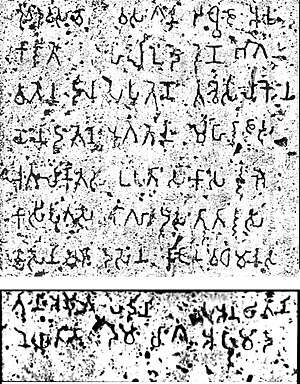 Heliodorus pillar rubbing (inverted colors). The text is in the Brahmi script of the Sunga period.[172] For a recent photograph. |
Middle Brahmi or "Kushana Brahmi" (1st-3rd centuries CE)
Middle Brahmi or "Kushana Brahmi" was in use from the 1st-3rd centuries CE. It is more rounded than its predecessor, and introduces some significant variations in shapes. Several characters (r̩ and l̩), classified as vowels, were added during the "Middle Brahmi" period between the 1st and 3rd centuries CE, in order to accommodate the transcription of Sanskrit:[173][174]
Independent vowels
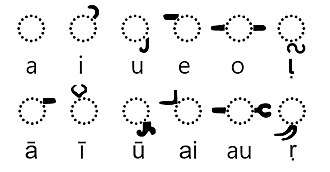
| Letter | IAST and Sanskrit IPA |
Letter | IAST and Sanskrit IPA |
|---|---|---|---|
| a /ə/ | ā /aː/ | ||
| i /i/ | ī /iː/ | ||
| u /u/ | ū /uː/ | ||
| e /eː/ | o /oː/ | ||
| ai /əi/ | au /əu/ | ||
| 𑀋 | ṛ /r̩/ | 𑀌 | ṝ /r̩ː/ |
| 𑀍 | l̩ /l̩/ | 𑀎 | ḹ /l̩ː/ |
Consonants
| Stop | Nasal | Approximant | Fricative | |||||||||||||
|---|---|---|---|---|---|---|---|---|---|---|---|---|---|---|---|---|
| Voicing → | Voiceless | Voiced | Voiceless | Voiced | ||||||||||||
| Aspiration → | No | Yes | No | Yes | No | Yes | ||||||||||
| Velar | ka /k/ | kha /kʰ/ | ga /g/ | gha /ɡʱ/ | ṅa /ŋ/ | ha /ɦ/ | ||||||||||
| Palatal | ca /c/ | cha /cʰ/ | ja /ɟ/ | jha /ɟʱ/ | ña /ɲ/ | ya /j/ | śa /ɕ/ | |||||||||
| Retroflex | ṭa /ʈ/ | ṭha /ʈʰ/ | ḍa /ɖ/ | ḍha /ɖʱ/ | ṇa /ɳ/ | ra /r/ | ṣa /ʂ/ | |||||||||
| Dental | ta /t̪/ | tha /t̪ʰ/ | da /d̪/ | dha /d̪ʱ/ | na /n/ | la /l/ | sa /s/ | |||||||||
| Labial | pa /p/ | pha /pʰ/ | ba /b/ | bha /bʱ/ | ma /m/ | va /w, ʋ/ | ||||||||||
Examples
 Early/Middle Brahmi legend on the coinage of Chastana: RAJNO MAHAKSHATRAPASA GHSAMOTIKAPUTRASA CHASHTANASA “Of the Rajah, the Great Satrap, son of Ghsamotika, Chashtana". 1st-2nd century CE.[175]
Early/Middle Brahmi legend on the coinage of Chastana: RAJNO MAHAKSHATRAPASA GHSAMOTIKAPUTRASA CHASHTANASA “Of the Rajah, the Great Satrap, son of Ghsamotika, Chashtana". 1st-2nd century CE.[175] Inscribed Kushan statue of Western Satraps King Chastana, with inscription "Shastana" in Middle Brahmi script of the Kushan period (
Inscribed Kushan statue of Western Satraps King Chastana, with inscription "Shastana" in Middle Brahmi script of the Kushan period (


Here, sta


 The rulers of the Western Satraps were called Mahākhatapa ("Great Satrap") in their Brahmi script inscriptions, as here in a dedicatory inscription by Prime Minister Ayama in the name of his ruler Nahapana, Manmodi Caves, circa 100 CE.[177]
The rulers of the Western Satraps were called Mahākhatapa ("Great Satrap") in their Brahmi script inscriptions, as here in a dedicatory inscription by Prime Minister Ayama in the name of his ruler Nahapana, Manmodi Caves, circa 100 CE.[177]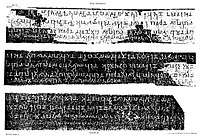 Nasik Cave inscription No.10. of Nahapana, Cave No.10.
Nasik Cave inscription No.10. of Nahapana, Cave No.10.
Late Brahmi or "Gupta Brahmi" (4th-6th centuries CE)
Independent vowels
| Letter | IAST and Sanskrit IPA |
Letter | IAST and Sanskrit IPA |
|---|---|---|---|
| a /ə/ | ā /aː/ | ||
| i /i/ | ī /iː/ | ||
| u /u/ | ū /uː/ | ||
| e /eː/ | o /oː/ | ||
| ai /əi/ | au /əu/ | ||
| 𑀋 | ṛ /r̩/ | 𑀌 | ṝ /r̩ː/ |
| 𑀍 | l̩ /l̩/ | 𑀎 | ḹ /l̩ː/ |
Consonants
| Stop | Nasal | Approximant | Fricative | |||||||||||||
|---|---|---|---|---|---|---|---|---|---|---|---|---|---|---|---|---|
| Voicing → | Voiceless | Voiced | Voiceless | Voiced | ||||||||||||
| Aspiration → | No | Yes | No | Yes | No | Yes | ||||||||||
| Velar | ka /k/ | kha /kʰ/ | ga /g/ | gha /ɡʱ/ | ṅa /ŋ/ | ha /ɦ/ | ||||||||||
| Palatal | ca /c/ | cha /cʰ/ | ja /ɟ/ | jha /ɟʱ/ | ña /ɲ/ | ya /j/ | śa /ɕ/ | |||||||||
| Retroflex | ṭa /ʈ/ | ṭha /ʈʰ/ | ḍa /ɖ/ | ḍha /ɖʱ/ | ṇa /ɳ/ | ra /r/ | ṣa /ʂ/ | |||||||||
| Dental | ta /t̪/ | tha /t̪ʰ/ | da /d̪/ | dha /d̪ʱ/ | na /n/ | la /l/ | sa /s/ | |||||||||
| Labial | pa /p/ | pha /pʰ/ | ba /b/ | bha /bʱ/ | ma /m/ | va /w, ʋ/ | ||||||||||
Examples
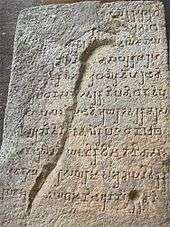 Gupta script on stone Kanheri Caves, one of the earliest descendants of Brahmi
Gupta script on stone Kanheri Caves, one of the earliest descendants of Brahmi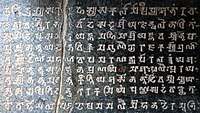

- Sanchi inscription of Chandragupta II.
Descendants
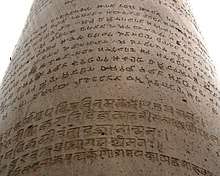
Over the course of a millennium, Brahmi developed into numerous regional scripts, commonly classified into a more rounded Southern India group and a more angular Northern India group. Over time, these regional scripts became associated with the local languages. A Northern Brahmi gave rise to the Gupta script during the Gupta Empire, sometimes also called "Late Brahmi" (used during the 5th century), which in turn diversified into a number of cursives during the Middle Ages, including the Siddhaṃ script (6th century), Śāradā script (9th century) and Devanagari (10th century).
Southern Brahmi gave rise to the Grantha alphabet (6th century), the Vatteluttu alphabet (8th century), and due to the contact of Hinduism with Southeast Asia during the early centuries CE, also gave rise to the Baybayin in the Philippines, the Javanese script in Indonesia, the Khmer alphabet in Cambodia, and the Old Mon script in Burma.
Also in the Brahmic family of scripts are several Central Asian scripts such as Tibetan, Tocharian (also called slanting Brahmi), and the one used to write the Saka language.
Several authors have suggested that the basic letters of hangul were modeled on the 'Phags-pa script of the Mongol Empire, itself a derivative of the Tibetan alphabet, a Brahmi script (see origin of Hangul).[184][185]
The arrangement of Brahmi was adopted as the modern order of Japanese kana, though the letters themselves are unrelated.[186]
| k- | kh- | g- | gh- | ṅ- | c- | ch- | j- | jh- | ñ- | ṭ- | ṭh- | ḍ- | ḍh- | ṇ- | t- | th- | d- | dh- | n- | p- | ph- | b- | bh- | m- | y- | r- | l- | v- | ś- | ṣ- | s- | h- | |
| Brahmi | 𑀓 | 𑀔 | 𑀕 | 𑀖 | 𑀗 | 𑀘 | 𑀙 | 𑀚 | 𑀛 | 𑀜 | 𑀝 | 𑀞 | 𑀟 | 𑀠 | 𑀡 | 𑀢 | 𑀣 | 𑀤 | 𑀥 | 𑀦 | 𑀧 | 𑀨 | 𑀩 | 𑀪 | 𑀫 | 𑀬 | 𑀭 | 𑀮 | 𑀯 | 𑀰 | 𑀱 | 𑀲 | 𑀳 |
| Gupta | |||||||||||||||||||||||||||||||||
| Devanagari | क | ख | ग | घ | ङ | च | छ | ज | झ | ञ | ट | ठ | ड | ढ | ण | त | थ | द | ध | न | प | फ | ब | भ | म | य | र | ल | व | श | ष | स | ह |
See also
- Early Indian epigraphy
- Lipi
- Pre-Islamic scripts in Afghanistan
- Sankhalipi
- Tamil-Brahmi
- Annaicoddai seal
Notes
- Aramaic is written from right to left, as are several early examples of Brahmi.[51] For example, Brahmi and Aramaic g (






- Bühler notes that other authors derive




- For example, according to Hultzsch, the first line of the First Edict at Shahbazgarhi (or at Mansehra) reads: "(Ayam) Dhrama-dipi Devanapriyasa Raño likhapitu" ("This Dharma-Edicts was written by King Devanampriya" Inscriptions of Asoka. New Edition by E. Hultzsch (in Sanskrit). 1925. p. 51.
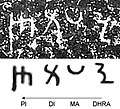 "Dhrama-Dipi" in Kharosthi script.
"Dhrama-Dipi" in Kharosthi script.
This appears in the reading of Hultzsch's original rubbing of the Kharoshthi inscription of the first line of the First Edict at Shahbazgarhi (here attached, which reads "Di"

- For example Column IV, Line 89
- More numerous inscribed Sanskrit records in Brahmi have been found near Mathura and elsewhere, but these are from the 1st century CE onwards.[113]
- The archeological sites near the northern Indian city of Mathura has been one of the largest source of such ancient inscriptions. Andhau (Gujarat) and Nasik (Maharashtra) are other important sources of Brahmi inscriptions from the 1st century CE.[114]
References
- Salomon 1998, pp. 11–13.
- Salomon, Richard (1998), Indian Epigraphy: A Guide to the Study of Inscriptions in Sanskrit, Prakrit, and the other Indo-Aryan Languages, New York: Oxford University Press, p. 17, ISBN 978-0-19-535666-3, OCLC 32854176 Quote: " Until the late nineteenth century, the script of the Aśokan (non-Kharosthi) inscriptions and its immediate derivatives was referred to by various names such as “lath” or “Lat,” “Southern Aśokan,” “Indian Pali,” “Mauryan,” and so on. The application to it of the name Brahmi [sc. lipi], which stands at the head of the Buddhist and Jaina script lists, was first suggested by T[errien] de Lacouperie, who noted that in the Chinese Buddhist encyclopedia Fa yiian chu lin the scripts whose names corresponded to the Brahmi and Kharosthi of the Lalitavistara are described as written from left to right and from right to left, respectively. He therefore suggested that the name Brahmi should refer to the left-to-right “Indo-Pali” script of the Aśokan pillar inscriptions, and Kharosthi to the right-to-left “Bactro-Pali” script of the rock inscriptions from the northwest."
- Salomon, Richard (1998), Indian Epigraphy: A Guide to the Study of Inscriptions in Sanskrit, Prakrit, and the other Indo-Aryan Languages, New York: Oxford University Press, p. 17, ISBN 978-0-19-535666-3, OCLC 32854176 Quote: "... the Brahmi script appeared in the third century B.c. as a fully developed pan-Indian national script (sometimes used as a second script even within the proper territory of Kharosthi in the north-west) and continued to play this role throughout history, becoming the parent of all of the modern Indic scripts both within India and beyond. Thus, with the exceptions of the Indus script in the protohistoric period, of Kharosthi in the northwest in the ancient period, and of the Perso-Arabic and European scripts in the medieval and modern periods, respectively, the history of writing in India is virtually synonymous with the history of the Brahmi script and its derivatives.
- Salomon, Richard, Indian Epigraphy: A Guide to the Study of Inscriptions in Sanskrit, Prakrit, and the other Indo-Aryan Languages, New York, pp. 42–46, ISBN 978-0-19-535666-3, OCLC 32854176 Quote: "The presumptive homeland and principal area of use of Kharosthi script was the territory along and around the Indus, Swat, and Kabul river valleys in the modern North-West Frontier Province of Pakistan. (p. 42–43) ... there is no clear evidence to allow us to specify the date of the origin of Kharosthi with any more precision that sometime in the fourth or possible fifth century BC."
- Salomon 1998, pp. 19–30.
- Salomon, Richard, On The Origin Of The Early Indian Scripts: A Review Article. Journal of the American Oriental Society 115.2 (1995), 271–279
- Brahmi, Encyclopedia Britannica (1999), Quote: "Among the many descendants of Brāhmī are Devanāgarī (used for Sanskrit, Hindi and other Indian languages), the Bengali and Gujarati scripts and those of the Dravidian languages"
- Nagrajji, Acharya Shri (2003), Āgama Aura Tripiṭaka, Eka Anuśilana: Language and literature, New Delhi: Concept Publishing, pp. 223–224
- Beckwith, Christopher I. (2017). Greek Buddha: Pyrrho's Encounter with Early Buddhism in Central Asia. Princeton University Press. p. 242. ISBN 978-0-691-17632-1.
- Ray, Himanshu Prabha (2017). Buddhism and Gandhara: An Archaeology of Museum Collections. Taylor & Francis. p. 181. ISBN 9781351252744.
- Asiatic Society of Bengal (1837). Journal of the Asiatic Society of Bengal. Oxford University.
- More details about Buddhist monuments at Sanchi Archived 2011-07-21 at the Wayback Machine, Archaeological Survey of India, 1989.
- Salomon 1998, p. 20.
- Scharfe, Hartmut (2002). "Kharosti and Brahmi". Journal of the American Oriental Society. 122 (2): 391–393. doi:10.2307/3087634. JSTOR 3087634.
- Keay 2000, p. 129–131.
- including "lath", "Laṭ", "Southern Aśokan", "Indian Pali" or "Mauryan" (Salomon 1998, p. 17)
- Falk 1993, p. 106.
- Rajgor 2007.
- Trautmann 2006, p. 64.
- Plofker 2009, pp. 44–45.
- Plofker 2009, p. 45.
- Plofker 2009, p. 47.
- Hayashi 2003, p. 119.
- Plofker 2007, pp. 396–397.
- Chhabra, B. Ch. (1970). Sugh Terracotta with Brahmi Barakhadi: appears in the Bulletin National Museum No. 2. New Delhi: National Museum.
- Georg Bühler (1898). On the Origin of the Indian Brahma Alphabet. K.J. Trübner. pp. 6, 14–15, 23, 29., Quote: "(...) a passage of the Lalitavistara which describes the first visit of Prince Siddhartha, the future Buddha, to the writing school..." (page 6); "In the account of Prince Siddhartha's first visit to the writing school, extracted by Professor Terrien de la Couperie from the Chinese translation of the Lalitavistara of 308 AD, there occurs besides the mention of the sixty-four alphabets, known also from the printed Sanskrit text, the utterance of the Master Visvamitra[.]"
- Salomon 1998, pp. 8–10 with footnotes
- Nado, Lopon (1982). "The Development of Language in Bhutan". The Journal of the International Association of Buddhist Studies. 5 (2): 95.
Under different teachers, such as the Brahmin Lipikara and Deva Vidyasinha, he mastered Indian philology and scripts. According to Lalitavistara, there were as many as sixty-four scripts in India.
- Tsung-i, Jao (1964). "Chinese Sources on Brāhmī and Kharoṣṭhī". Annals of the Bhandarkar Oriental Research Institute. 45 (1/4): 39–47. JSTOR 41682442.
- Salomon 1998, p. 9.
- Falk 1993, pp. 109–167.
- Salomon 1998, pp. 19–20
- Salomon 1996, p. 378.
- Bühler 1898, p. 2.
- S. R. Goyal in: S.P.Gupta, K.S.Ramachandran (eds.), The Origin of Brahmi Script (1979), cited after Salomon (1998).
- Salomon (1998), p. 19, fn. 42: "there is no doubt some truth in Goyal's comment that some of their views have been affected by 'nationalist bias' and 'imperialist bias,' respectively."
- Cunningham, Alexander (1877). Corpus Inscriptionum Indicarum v. 1: Inscriptions of Asoka. Calcutta: Superintendent of Government Printing. p. 54.
- F. R. Allchin; George Erdosy (1995). The Archaeology of Early Historic South Asia: The Emergence of Cities and States. Cambridge University Press. pp. 309–310. ISBN 978-0-521-37695-2.
- L. A. Waddell (1914), Besnagar Pillar Inscription B Re-Interpreted, The Journal of the Royal Asiatic Society of Great Britain and Ireland, Cambridge University Press, pages 1031-1037
- Brahmi, Encyclopedia Britannica (1999), Quote: "Brāhmī, writing system ancestral to all Indian scripts except Kharoṣṭhī. Of Aramaic derivation or inspiration, it can be traced to the 8th or 7th century BC, when it may have been introduced to Indian merchants by people of Semitic origin. (...) a coin of the 4th century BC, discovered in Madhya Pradesh, is inscribed with Brāhmī characters running from right to left."
- Salomon 1998, pp. 18–24.
- Salomon 1998, pp. 23, 46–54
- Salomon 1998, p. 19-21 with footnotes.
- Annette Wilke & Oliver Moebus 2011, p. 194 with footnote 421.
- Trigger, Bruce G. (2004), "Writing Systems: a case study in cultural evolution", in Stephen D. Houston (ed.), The First Writing: Script Invention as History and Process, Cambridge University Press, pp. 60–61
- Justeson, J.S.; Stephens, L.D. (1993). "The evolution of syllabaries from alphabets". Die Sprache. 35: 2–46.
- Bühler 1898, p. 84–91.
- Salomon 1998, pp. 23–24.
- Salomon 1998, p. 28.
- Bühler 1898, p. 59,68,71,75.
- Salomon 1996.
- Salomon 1998, p. 25.
- Andersen, F.I.; Freedman, D.N. (1992). "Aleph as a vowel in Old Aramaic". Studies in Hebrew and Aramaic Orthography. Winona Lake, Indiana: Eisenbrauns. pp. 79–90.
- Bühler 1898, p. 76-77.
- Bühler 1898, p. 82-83.
- Gnanadesikan, Amalia E. (2009), The Writing Revolution: Cuneiform to the Internet, John Wiley and Sons Ltd., pp. 173–174
- Hultzsch, E. (1925). Corpus Inscriptionum Indicarum v. 1: Inscriptions of Asoka. Oxford: Clarendon Press. p. xlii. Retrieved 8 April 2015.
- Scharfe, Hartmut (2002), Education in Ancient India, Handbook of Oriental Studies, Leiden, Netherlands: Brill Publishers, pp. 10–12
- Tavernier, Jan (2007). "The Case of Elamite Tep-/Tip- and Akkadian Tuppu". Iran. 45: 57–69. doi:10.1080/05786967.2007.11864718. Retrieved 8 April 2015.
- "Falk goes too far. It is fair to expect that we believe that Vedic memorisation — though without parallel in any other human society — has been able to preserve very long texts for many centuries without losing a syllable. (...) However, the oral composition of a work as complex as Pāṇini’s grammar is not only without parallel in other human cultures, it is without parallel in India itself. (...) It just will not do to state that our difficulty in conceiving any such thing is our problem." Bronkhorst, Johannes (2002). "Literacy and Rationality in Ancient India". Asiatische Studien/Études Asiatiques. 56 (4): 803–804, 797–831.
- Falk 1993.
- Annette Wilke & Oliver Moebus 2011, p. 194, footnote 421.
- Salomon, Richard (1995). "Review: On the Origin of the Early Indian Scripts". Journal of the American Oriental Society. 115 (2): 271–278. doi:10.2307/604670. JSTOR 604670.
- Salomon 1998, p. 22.
- Salomon 1998, pp. 23.
- Falk 1993, pp. 104.
- Salomon 1998, pp. 19–24.
- Falk, Harry (2018). "The Creation and Spread of Scripts in Ancient India". Literacy in Ancient Everyday Life, pp.43-66: see pages 57–58 for the online publication. doi:10.1515/9783110594065-004.
- Iravatham Mahadevan (2003). Early Tamil Epigraphy. Harvard University Department of Sanskrit and Indian Studies. pp. 91–94. ISBN 978-0-674-01227-1.;
Iravatham Mahadevan (1970). Tamil-Brahmi Inscriptions. State Department of Archaeology, Government of Tamil Nadu. pp. 1–12. - Bertold Spuler (1975). Handbook of Oriental Studies. Brill Academic. p. 44. ISBN 90-04-04190-7.
- John Marshall (1931). Mohenjo-daro and the Indus civilization: being an official account of archaeological excavations at Mohenjo-Daro carried out by the government of India between the years 1922 and 1927. Asian Educational Services. p. 423. ISBN 978-81-206-1179-5., Quote: "Langdon also suggested that the Brahmi script was derived from the Indus writing, (...)".
- Senarat Paranavitana; Leelananda Prematilleka; Johanna Engelberta van Lohuizen-De Leeuw (1978). Studies in South Asian Culture: Senarat Paranavitana Commemoration Volume. Brill Academic. p. 119. ISBN 90-04-05455-3.
- Georg Feuerstein; Subhash Kak; David Frawley (2005). The Search of the Cradle of Civilization: New Light on Ancient India. Motilal Banarsidass. pp. 136–137. ISBN 978-81-208-2037-1.
- Jack Goody (1987). The Interface Between the Written and the Oral. Cambridge University Press. pp. 301 footnote 4. ISBN 978-0-521-33794-6., Quote: "In recent years, I have been leaning towards the view that the Brahmi script had an independent Indian evolution, probably emerging from the breakdown of the old Harappan script in the first half of the second millennium BC".
- Goody, Jack (1987), The Interface Between the Written and the Oral, Cambridge University Press, pp. 301–302 (note 4)
- Allchin, F.Raymond; Erdosy, George (1995), The Archaeology of Early Historic South Asia: The Emergence of Cities and States, Cambridge University Press, p. 336
- Hunter, G.R. (1934), The Script of Harappa and Mohenjodaro and Its Connection with Other Scripts, Studies in the history of culture, London:K. Paul, Trench, Trubner
- Kak, Subhash (1994), "The evolution of early writing in India" (PDF), Indian Journal of History of Science, 28: 375–388
- Kak, S. (2005). Akhenaten, Surya, and the Rigveda. in "The Golden Chain" Govind Chandra Pande (editor), CRC, 2005. http://www.ece.lsu.edu/kak/Akhenaten.pdf
- Kak, S. (1988). A frequency analysis of the Indus script. Cryptologia 12: 129–143. http://www.ece.lsu.edu/kak/IndusFreqAnalysis.pdf
- Kak, S. (1990) Indus and Brahmi – further connections, Cryptologia 14: 169–183
- Das, S. ; Ahuja, A. ; Natarajan, B. ; Panigrahi, B.K. (2009) Multi-objective optimization of Kullback-Leibler divergence between Indus and Brahmi writing. World Congress on Nature & Biologically Inspired Computing, 2009. NaBIC 2009.1282 – 1286. ISBN 978-1-4244-5053-4
- Salomon 1998, pp. 20–21.
- Khan, Omar. "Mahadevan Interview: Full Text". Harappa. Retrieved 4 June 2015.
- Ray, Himanshu Prabha (2006), "Inscribed pots, emerging identities", in Patrick Olivelle (ed.), Between the Empires : Society in India 300 BCE to 400 CE, Oxford University Press, pp. 121–122
- Fábri, C. L. (1935). "The Punch-Marked Coins: A Survival of the Indus Civilization". The Journal of the Royal Asiatic Society of Great Britain and Ireland (2): 307–318. JSTOR 25201111.
- Salomon 1998, p. 21.
- Masica 1993, p. 135.
- Hultzsch, E. (1925). Corpus Inscriptionum Indicarum v. 1: Inscriptions of Asoka. Oxford: Clarendon Press. p. xlii.
- Sharma, R. S. (2006). India's Ancient Past. Oxford University Press. p. 163. ISBN 9780199087860.
- "The word dipi appears in the Old Persian inscription of Darius I at Behistan (Column IV. 39) having the meaning inscription or "written document" in Congress, Indian History (2007). Proceedings – Indian History Congress. p. 90.
- Scharfe, Hartmut (2002), Education in Ancient India, Handbook of Oriental Studies, Leiden, Netherlands: Brill Publishers, p. 9
- Strabo (1903). Hamilton, H.C.; Falconer, W. (eds.). The Geography of Strabo. Literally translated, with notes, in three volumes. London: George Bell and Sons. p. 15.1.53.
- Rocher 2014.
- Timmer 1930, p. 245.
- Strabo (1903). Hamilton, H.C.; Falconer, W. (eds.). The Geography of Strabo. Literally translated, with notes, in three volumes. London: George Bell and Sons. p. 15.1.39.
- Sterling, Gregory E. (1992). Historiography and Self-Definition: Josephos, Luke-Acts, and Apologetic Historiography. Brill. p. 95.
- McCrindle, J.W. (1877). Ancient India As Described By Megasthenes And Arrian. London: Trübner and Co. pp. 40, 209. Retrieved 14 April 2015.
- Salomon 1998, p. 11.
- Oskar von Hinüber (1989). Der Beginn der Schrift und frühe Schriftlichkeit in Indien. Akademie der Wissenschaften und der Literatur. pp. 241–245. OCLC 22195130.
- Kenneth Roy Norman (2005). Buddhist Forum Volume V: Philological Approach to Buddhism. Routledge. pp. 67, 56–57, 65–73. ISBN 978-1-135-75154-8.
- Jack Goody (1987). The Interface Between the Written and the Oral. Cambridge University Press. pp. 110–124. ISBN 978-0-521-33794-6.
- Jack Goody (2010). Myth, Ritual and the Oral. Cambridge University Press. pp. 42–47, 65–81. ISBN 978-1-139-49303-1.
- Annette Wilke & Oliver Moebus 2011, pp. 182–183.
- Walter J. Ong; John Hartley (2012). Orality and Literacy: The Technologizing of the Word. Routledge. pp. 64–69. ISBN 978-0-415-53837-4.
- Levi, Silvain (1906), "The Kharostra Country and the Kharostri Writing", The Indian Antiquary, XXXV: 9
- Monier Monier-Williams (1970). Sanskrit-English dictionary. Motilal Banarsidass (Reprint of Oxford Claredon). p. xxvi with footnotes. ISBN 978-5-458-25035-1.
- Arthur Anthony Macdonell (2004). Sanskrit English Dictionary (Practical Hand Book). Asian Educational Services. p. 200. ISBN 978-81-206-1779-7.
- Monier Monier Willians (1899), Brahmi, Oxford University Press, page 742
- Salomon 1998, pp. 72–81.
- Salomon 1998, pp. 86–87.
- Salomon 1998, pp. 87–89.
- Salomon 1998, p. 82.
- Salomon 1998, pp. 81–84.
- Salomon 1996, p. 377.
- Salomon 1998, pp. 122–123, 129–131, 262–307.
- Salomon 1998, pp. 12–13.
- Coningham, R.A.E.; Allchin, F.R.; Batt, C.M.; Lucy, D. (22 December 2008). "Passage to India? Anuradhapura and the Early Use of the Brahmi Script". Cambridge Archaeological Journal. 6 (1): 73. doi:10.1017/S0959774300001608.
- Falk, H. (2014). "Owner's graffiti on pottery from Tissamaharama", in Zeitchriftfür Archäeologie Aussereuropäischer Kulturen. 6. pp.45–47.
- Rajan prefers the term "Prakrit-Brahmi" to distinguish Prakrit-language Brahmi inscriptions.
- Rajan, K.; Yatheeskumar, V.P. (2013). "New evidences on scientific dates for Brāhmī Script as revealed from Porunthal and Kodumanal Excavations" (PDF). Prāgdhārā. 21–22: 280–295. Archived from the original (PDF) on 13 October 2015. Retrieved 12 January 2016.
- Falk, H. (2014), p.46, with footnote 2
- Journal of the Asiatic Society of Bengal. Calcutta : Printed at the Baptist Mission Press [etc.] 1838.
- Salomon 1998, pp. 204–206.
- Salomon, Richard (1998). Indian Epigraphy. pp. 206–207.
- Salomon, Richard (1998). Indian Epigraphy. pp. 204–208.
- Journal of the Asiatic Society of Bengal. Calcutta : Printed at the Baptist Mission Press [etc.] 1834. pp. 495–499.
- Four Reports Made During the Years 1862-63-64-65 by Alexander Cunningha M: 1/ by Alexander Cunningham. 1. Government central Press. 1871. p. XII.
- Journal of the Asiatic Society of Bengal Vol V 1836. p. 723.
- Extract of Prinsep's communication about Lassen's decipherment in Journal of the Asiatic Society of Bengal Vol V 1836. 1836. pp. 723–724.
- Four Reports Made During the Years 1862-63-64-65 by Alexander Cunningha M: 1/ by Alexander Cunningham. 1. Government central Press. 1871. p. XI.
- Keay, John (2011). To cherish and conserve the early years of the archaeological survey of India. Archaeological Survey of India. pp. 30–31.
- Four Reports Made During the Years 1862-63-64-65 by Alexander Cunningha M: 1/ by Alexander Cunningham. 1. Government central Press. 1871. p. XIII.
- Salomon 1998, p. 207.
- Ashoka: The Search for India's Lost Emperor, Charles Allen, Little, Brown Book Group Limited, 2012
- Journal of the Asiatic Society of Bengal. Calcutta : Printed at the Baptist Mission Press [etc.] 1838. pp. 219–285.
- Salomon 1998, p. 208.
- Epigraphia Zeylanica: 1904–1912, Volume 1. Government of Sri Lanka, 1976. http://www.royalasiaticsociety.lk/inscriptions/?q=node/12 Archived 2016-08-26 at the Wayback Machine
- Raghupathy, Ponnambalam (1987). Early settlements in Jaffna, an archaeological survey. Madras: Raghupathy.
- P Shanmugam (2009). Hermann Kulke; et al. (eds.). Nagapattinam to Suvarnadwipa: Reflections on the Chola Naval Expeditions to Southeast Asia. Institute of Southeast Asian Studies. p. 208. ISBN 978-981-230-937-2.
- Frederick Asher (2018). Matthew Adam Cobb (ed.). The Indian Ocean Trade in Antiquity: Political, Cultural and Economic Impacts. Taylor & Francis Group. p. 158. ISBN 978-1-138-73826-3.
- Salomon 1998, pp. 27–28.
- Salomon 1996, pp. 373–4.
- Bühler 1898, p. 32.
- Bühler 1898, p. 33.
- Daniels, Peter T. (2008), "Writing systems of major and minor languages", Language in South Asia, Cambridge University Press, p. 287
- Trautmann 2006, p. 62–64.
- Chakrabarti, Manika (1981). Mālwa in Post-Maurya Period: A Critical Study with Special Emphasis on Numismatic Evidences. Punthi Pustak. p. 100.
- Ram Sharma, Brāhmī Script: Development in North-Western India and Central Asia, 2002
- Stefan Baums (2006). "Towards a computer encoding for Brahmi". In Gail, A.J.; Mevissen, G.J.R.; Saloman, R. (eds.). Script and Image: Papers on Art and Epigraphy. New Delhi: Shri Jainendra Press. pp. 111–143.
- Singh, Upinder (2008). A History of Ancient and Early Medieval India: From the Stone Age to the 12th Century. Pearson Education India. p. 43. ISBN 9788131711200.
- Evolutionary chart, Journal of the Asiatic Society of Bengal Vol 7, 1838
- Inscriptions of the Edicts of Ashoka
- Inscriptions of Western Satrap Rudradaman I on the rock at Girnar circa 150 CE
- Kushan Empire inscriptions circa 150-250 CE.
- Gupta Empire inscription of the Allahabad Pillar by Samudragupta circa 350 CE.
- Google Noto Fonts – Download Noto Sans Brahmi zip file
- Adinatha font announcement
- Script and Font Support in Windows – Windows 10 Archived 2016-08-13 at the Wayback Machine, MSDN Go Global Developer Center.
- Hultzsch, E. /1925). Inscriptions of Asoka. Oxford: Clarendon Press, pp. 164–165
- Hultzsch, E. (1925). Inscriptions of Asoka. Oxford: Clarendon Press, pp. 164–165
- Hultzsch, E. (1925). Inscriptions of Asoka. New Edition by E. Hultzsch (in Sanskrit). p. 164.
- Avari, Burjor (2016). India: The Ancient Past: A History of the Indian Subcontinent from C. 7000 BCE to CE 1200. Routledge. p. 167. ISBN 9781317236733.
- Greek Culture in Afghanistan and India: Old Evidence and New Discoveries Shane Wallace, 2016, p.222-223
- Osmund Bopearachchi, 2016, Emergence of Viṣṇu and Śiva Images in India: Numismatic and Sculptural Evidence
- Burjor Avari (2016). India: The Ancient Past: A History of the Indian Subcontinent from C. 7000 BCE to CE 1200. Routledge. pp. 165–167. ISBN 978-1-317-23673-3.
- Romila Thapar (2004). Early India: From the Origins to AD 1300. University of California Press. pp. 216–217. ISBN 978-0-520-24225-8.
- Archaeological Survey of India, Annual report 1908-1909 p.129
- Rapson, E. J. (1914). Ancient India. p. 157.
- Sukthankar, Vishnu Sitaram, V. S. Sukthankar Memorial Edition, Vol. II: Analecta, Bombay: Karnatak Publishing House 1945 p.266
- R. Salomon, Indian Epigraphy. A Guide to the Study of Inscriptions in Sanskrit, Prakrit, and the Other Indo-Aryan Languages (Oxford, 1998), 265–7
- Brahmi Unicode (PDF). pp. 4–6.
- James Prinsep table of vowels
- Seaby's Coin and Medal Bulletin: July 1980. Seaby Publications Ltd. 1980. p. 219.
- "The three letters give us a complete name, which I read as Ṣastana (vide facsimile and cast). Dr. Vogel read it as Mastana but that is incorrect for Ma was always written with a circular or triangular knob below with two slanting lines joining the knob" in Journal of the Bihar and Orissa Research Society. The Society. 1920.
- Burgess, Jas (1883). Archaeological Survey Of Western India. p. 103.
- Das Buch der Schrift: Enthaltend die Schriftzeichen und Alphabete aller ... (in German). K.K. Hof- und Staatsdruckerei. 1880. p. 126.
- "Gupta Unicode" (PDF).
- The "h" (

- Verma, Thakur Prasad (2018). The Imperial Maukharis: History of Imperial Maukharis of Kanauj and Harshavardhana (in Hindi). Notion Press. p. 264. ISBN 9781643248813.
- Sircar, D. C. (2008). Studies in Indian Coins. Motilal Banarsidass. p. 376. ISBN 9788120829732.
- Tandon, Pankaj (2013). Notes on the Evolution of Alchon Coins Journal of the Oriental Numismatic Society, No. 216, Summer. Oriental Numismatic Society. pp. 24–34. also Coinindia Alchon Coins (for an exact description of this coin type)
- Ledyard 1994, p. 336–349.
- Daniels, Peter T. (Spring 2000). "On Writing Syllables: Three Episodes of Script Transfer" (PDF). Studies in the Linguistic Sciences. 30 (1): 73–86.
- Smith, Janet S. (Shibamoto) (1996). "Japanese Writing". In Daniels, Peter T.; Bright, William (eds.). The World's Writing Systems. Oxford University Press. pp. 209–17. ISBN 0-19-507993-0.
- Evolutionary chart, Journal of the Asiatic Society of Bengal Vol 7, 1838
Bibliography
- Annette Wilke; Oliver Moebus (2011). Sound and Communication: An Aesthetic Cultural History of Sanskrit Hinduism. Walter de Gruyter. ISBN 978-3-11-024003-0.CS1 maint: ref=harv (link)
- Bühler, Georg (1898). On the Origin of the Indian Brahma Alphabet. Strassburg K.J. Trübner.CS1 maint: ref=harv (link)
- Deraniyagala, Siran (2004). The Prehistory of Sri Lanka: An Ecological Perspective. Department of Archaeological Survey, Government of Sri Lanka. ISBN 978-955-9159-00-1.CS1 maint: ref=harv (link)
- Falk, Harry (1993). Schrift im alten Indien: ein Forschungsbericht mit Anmerkungen (in German). Gunter Narr Verlag.CS1 maint: ref=harv (link)
- Gérard Fussman, Les premiers systèmes d'écriture en Inde, in Annuaire du Collège de France 1988–1989 (in French)
- Hayashi, Takao (2003), "Indian Mathematics", in Grattan-Guinness, Ivor (ed.), Companion Encyclopedia of the History and Philosophy of the Mathematical Sciences, 1, pp. 118–130, Baltimore, MD: The Johns Hopkins University Press, 976 pages, ISBN 978-0-8018-7396-6.
- Oscar von Hinüber, Der Beginn der Schrift und frühe Schriftlichkeit in Indien, Franz Steiner Verlag, 1990 (in German)
- Keay, John (2000). India: A History. Grove Press. ISBN 978-0-8021-3797-5.CS1 maint: ref=harv (link)
- Ledyard, Gari (1994). The Korean Language Reform of 1446: The Origin, Background, and Early History of the Korean Alphabet. University Microfilms.CS1 maint: ref=harv (link)
- Masica, Colin (1993). The Indo-Aryan Languages. Cambridge University Press. ISBN 978-0-521-29944-2.CS1 maint: ref=harv (link)
- Norman, Kenneth R. (1992). "The Development of Writing in India and its Effect upon the Pāli Canon". Wiener Zeitschrift für die Kunde Südasiens / Vienna Journal of South Asian Studies. 36 (Proceedings of the VIIIth World Sanskrit Conference Vienna): 239–249.
- Patel, Purushottam G.; Pandey, Pramod; Rajgor, Dilip (2007). The Indic Scripts: Palaeographic and Linguistic Perspectives. D.K. Printworld. ISBN 978-81-246-0406-9.CS1 maint: ref=harv (link)
- Plofker, K. (2007), "Mathematics of India", in Katz, Victor J. (ed.), The Mathematics of Egypt, Mesopotamia, China, India, and Islam: A Sourcebook, Princeton, NJ: Princeton University Press, 685 pages, pp 385–514, pp. 385–514, ISBN 978-0-691-11485-9.
- Plofker, Kim (2009), Mathematics in India: 500 BCE–1800 CE, Princeton, NJ: Princeton University Press. Pp. 384., ISBN 978-0-691-12067-6.
- Rocher, Ludo (2014). Studies in Hindu Law and Dharmaśāstra. Anthem Press. ISBN 978-1-78308-315-2.CS1 maint: ref=harv (link)
- Salomon, Richard (1996). "Brahmi and Kharoshthi". In Daniels, Peter T.; Bright, William (eds.). The World's Writing Systems. Oxford University Press. ISBN 0-19-507993-0.CS1 maint: ref=harv (link)
- Salomon, Richard (1998). Indian Epigraphy: A Guide to the Study of Inscriptions in Sanskrit, Prakrit, and the other Indo-Aryan Languages. Oxford University Press. ISBN 978-0-19-535666-3.CS1 maint: ref=harv (link)
- Salomon, Richard (1995). "On the Origin of the Early Indian Scripts". Journal of the American Oriental Society. 115 (2): 271–279. doi:10.2307/604670. JSTOR 604670.
- Salomon, Richard (1998). Indian Epigraphy: A Guide to the Study of Inscriptions in Sanskrit, Prakrit, and the Other Indo-Aryan Languages. Oxford: Oxford University Press. ISBN 0-19-509984-2.CS1 maint: ref=harv (link)
- Trautmann, Thomas (2006). Languages and Nations: The Dravidian Proof in Colonial Madras. University of California Press. ISBN 978-0-520-24455-9.CS1 maint: ref=harv (link)
- Timmer, Barbara Catharina Jacoba (1930). Megasthenes en de Indische maatschappij. H.J. Paris.CS1 maint: ref=harv (link)
External links
| Wikimedia Commons has media related to Brahmi script. |
- "Brahmi Home". brahmi.sourceforge.net. of the Indian Institute of Science
- "Ancient Scripts: Brahmi". www.ancientscripts.com.
- "Brahmi Texts | Virtual Vinodh". www.virtualvinodh.com.
- Indoskript 2.0, a paleographic database of Brahmi and Kharosthi
